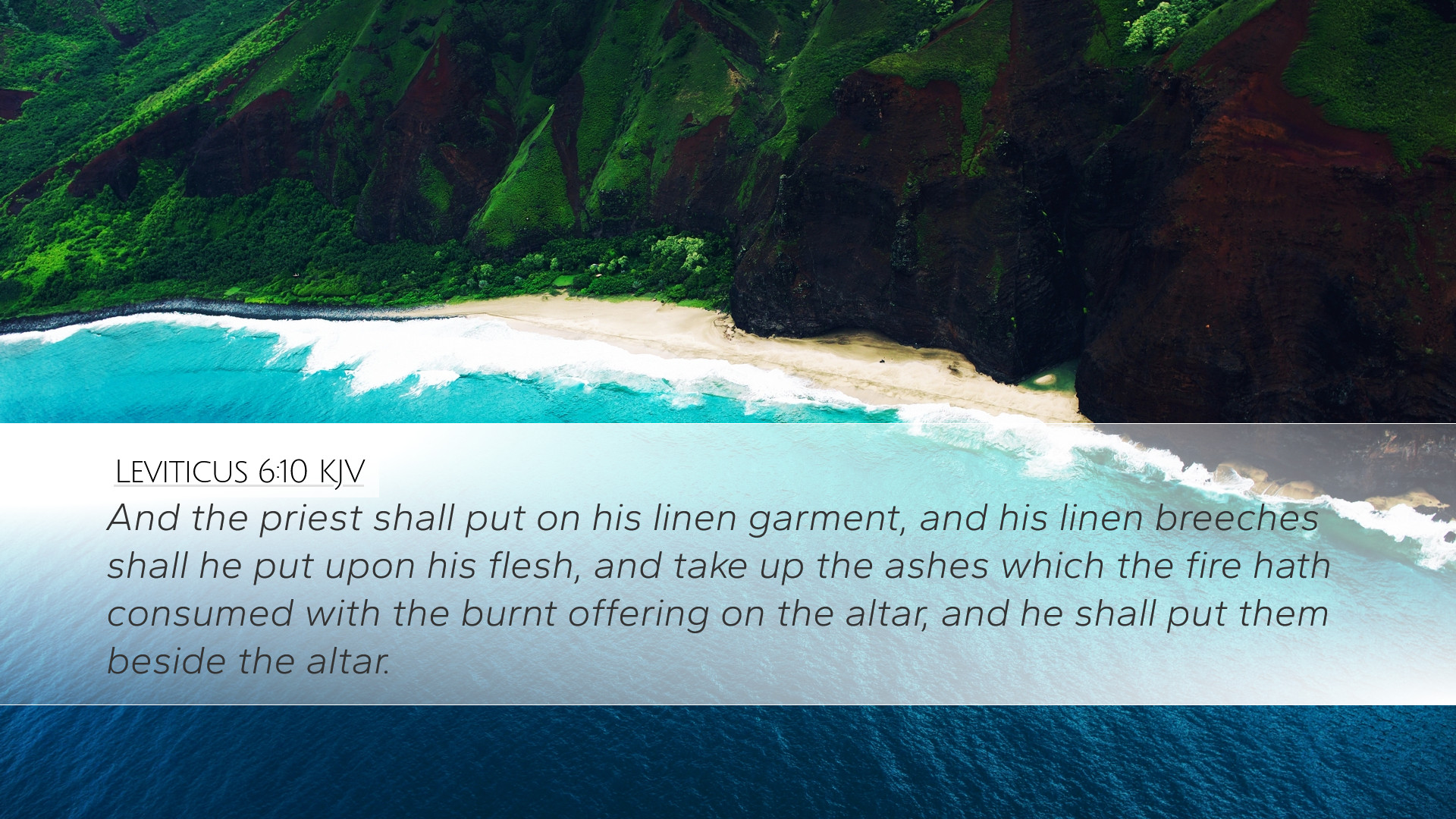Commentary on Leviticus 6:10
Verse: Leviticus 6:10 - "And the priest shall put on his linen garment, and his linen breeches shall he put upon his flesh, and take up the ashes which the fire hath consumed with the burnt offering on the altar, and he shall put them beside the altar."
Introduction
This verse forms part of the detailed instructions regarding the offerings and the priestly duties associated with them. It particularly focuses on the care and handling of the ashes of the burnt offerings, emphasizing the holiness required in the service of God. The priest's attire and actions are laden with significant theological meaning and practical implications for worship.
Historical Context
The book of Leviticus details the laws and rituals to be followed by the Israelites, particularly the priests, in maintaining their covenantal relationship with God. It delineates the roles, responsibilities, and the profound seriousness of the sacrificial system. Each element in the sacrificial process symbolizes deeper truths about sin, atonement, holiness, and the need for divine acceptance.
Priestly Attire
Matthew Henry's Insight: Matthew Henry emphasizes that the linen garments of the priest symbolize purity and the necessity of holiness in every aspect of worship. The choice of linen reflects both a practical consideration—comfortable and cool for the priests—and a spiritual one, embodying the righteousness that ought to characterize those who serve before God.
Albert Barnes adds: The linen breeches mentioned were a critical part of the priestly garments. They served to cover the priest’s flesh, symbolizing modesty and propriety. This highlights that even in the service of the sacred, human dignity and divine respect must be maintained.
Handling of the Ashes
This verse directs the actions of the priest in dealing with the ashes of the burnt offering. The ashes represent the residue of the sacrifice, signifying the completion of an offering made to God.
Adam Clarke elaborates: He reflects on the importance of the ashes as a reminder of the sacrifice's efficacy. The burnt offering, consumed entirely by fire, signifies complete surrender to God. The act of removing the ashes indicates the continual work of the priest in the sacrificial system. The priest acts not only as a servant but as an intermediary between God and the people.
Symbolism of Fire and Ashes
The fire that consumes the sacrifice is representative of God’s holy presence. The ashes then symbolize the transformative power of that fire in a spiritual context.
Matthew Henry notes: The work of the priest in removing the ashes illustrates the ongoing nature of atonement. It serves as a reminder that while the sacrifice was acceptable, it also points to the ongoing need for reconciliation and worship in the lives of the Israelites.
Theological Implications
This passage and its accompanying duties highlight several theological truths. It underscores the need for holiness in worship, the significance of priests as mediators, and the continuous nature of sanctification in the life of believers.
Holiness in Worship
Albert Barnes asserts: The necessity for the priest to wear specific garments while performing sacred duties reflects the overarching biblical principle of holiness. Worship is not merely a personal or communal act; it requires an understanding of God's holiness and the need for purity in approaching Him.
Priestly Mediation
Adam Clarke highlights: The imagery of the priest handling the ashes illustrates Christ's mediatorial role. Just as the priest dealt with the remnants of sacrifice, so Christ, our High Priest, continually intercedes on behalf of humanity. The priest's actions prefigure the redemptive work of Christ and point to the necessity of ongoing intercession for believers.
Ongoing Need for Atonement
The removal of ashes, while signifying that an offering had been made, also emphasizes the need for continual offerings. Spiritual life requires regular acknowledgment of sin and the need for atonement.
Practical Application for Today
As we reflect on this verse and its implications, several key applications arise for pastors, theologians, and students of Scripture:
- Importance of Holiness: Just as the priests were to act in holiness, so must modern-day believers uphold holiness in worship, personal conduct, and community life.
- Understanding of Sacred Duties: Those who serve in ministry must recognize the weight of their responsibilities. Worship and ministry should never be taken lightly but approached with reverence and a deep sense of accountability.
- Christ as Our Mediator: Recognizing the ashes as a symbol of Christ’s ultimate sacrifice may deepen one's understanding of the gospel and the necessity of continual repentance and reliance on Christ’s work.
- Reflection on Sacrifice: Believers are called to live sacrificially, echoing the spirit of the burnt offering in their daily lives, surrendering to God's will in every aspect.
Conclusion
Leviticus 6:10 serves as a profound reminder of the holiness required in the worship of God. It calls forth reflections on the nature of the priestly role, the significance of sacrifices, and points forward to the ultimate sacrifice of Christ. As we consider these insights from traditional commentaries, may we be moved to a deeper understanding of our relationship with God and a renewed commitment to holiness in our lives of worship and service.


